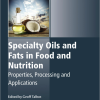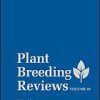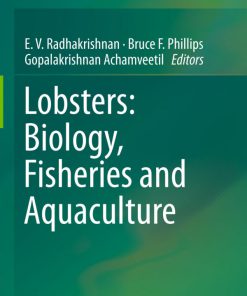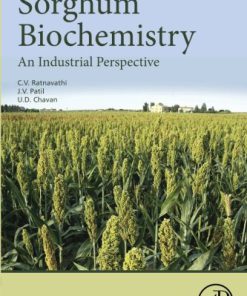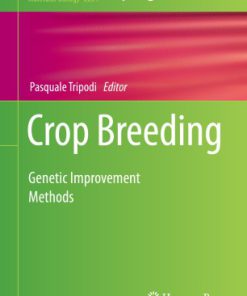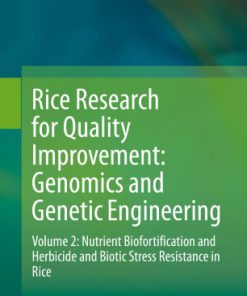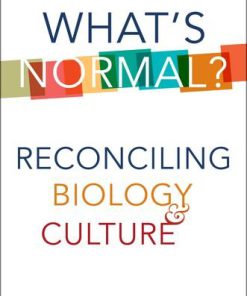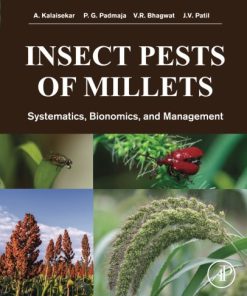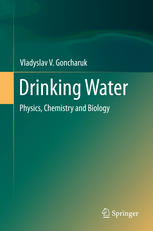Millets and Sorghum Biology and Genetic Improvement 1st Edition by Jagannath Patil 1119130772 9781119130772
$50.00 Original price was: $50.00.$25.00Current price is: $25.00.
Millets and Sorghum Biology and Genetic Improvement 1st Edition by Jagannath V. Patil – Ebook PDF Instant Download/DeliveryISBN: 1119130772, 9781119130772
Full download Millets and Sorghum Biology and Genetic Improvement 1st Edition after payment.
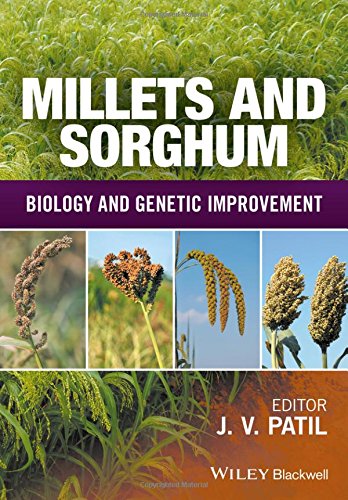
Product details:
ISBN-10 : 1119130772
ISBN-13 : 9781119130772
Author: Jagannath V. Patil
Millets and sorghum are extremely important crops in many developing nations and because of the ability of many of them to thrive in low-moisture situations they represent some exciting opportunities for further development to address the continuing and increasing impact of global temperature increase on the sustainability of the world’s food crops. The main focus of this thorough new book is the potential for crop improvement through new and traditional methods, with the book’s main chapters covering the following crops: sorghum, pearl millet, finger millet, foxtail milet, proso millet, little millet, barnyard millet, kodo millet, tef and fonio. Further chapters cover pests and diseases, nutritional and industrial importance, novel tools for improvement, and seed systems in millets. Millets and Sorghum provides full and comprehensive coverage of these crucially important crops, their biology, world status and potential for improvement, and is an essential purchase for crop and plant scientists, and food scientists and technologists throughout the developed and developing world. All libraries in universities and research establishment where biological and agricultural sciences are studied and taught should have copies of this important book on their shelves.
Millets and Sorghum Biology and Genetic Improvement 1st Table of contents:
Chapter 1: Sorghum, Sorghum bicolor (L.) Moench
1.1 Introduction
1.2 Origin and Taxonomy
1.3 Germplasm Resources and Utilisation
1.4 Genetics and Cytogenetics
1.5 Reproductive Biology
1.6 Production Constraints
1.7 Breeding Objectives
1.8 Sorghum Improvement Across Diverse Parts of the World
1.9 Future Prospects
References
Chapter 2: Pearl Millet, Pennisetum glaucum (L.) R. Br.
2.1 Introduction
2.2 Origin and Taxonomy
2.3 Genetic Resources
2.4 Genetics of Important Traits
2.5 Morphology and ReproductiveBiology
2.6 Selfing and Crossing
2.7 Breeding Methods
2.8 Cultivar Development
2.9 CMS Systems in Pearl Millet
2.10 Production Constraints
2.11 Grain Quality
2.12 Alternate Uses of Pearl Millet
2.13 Future Research Thrust Areas
References
Chapter 3: Improvement in Finger Millet: Status and Future Prospects
3.1 Introduction
3.2 Area Production and Productivity
3.3 Origin and Domestication
3.4 Botanical Features and Breeding Behaviour
3.5 Emasculation and Pollination Techniques
3.6 Genetics of Traits
3.7 Gene Pool of Eleusine coracana
3.8 Germplasm and Genetic Diversity
3.9 Varietal Improvement in India
3.10 Varietal Development in Africa
3.11 Genetic Improvement for Blast Resistance
3.12 Development of Genetic Male Sterility
3.13 Mutation Breeding
3.14 Strategies to Bridge Research Gaps for Enhancing Productivity and Utilisation of Finger Millet
References
Chapter 4: Foxtail Millet, Setaria italica (L.) P. Beauv.
4.1 Introduction
4.2 Origin and Taxonomy
4.3 Germplasm Resources and Utilisation
4.4 Genetics and Cytogenetics
4.5 Reproductive Biology
4.6 Breeding Objectives
4.7 Breeding Methods
4.8 Breeding Efforts in the United States
4.9 Breeding Efforts in China
4.10 Breeding Efforts in India
4.11 New Tools for Genetic Improvement
4.12 Future Prospects
References
Chapter 5: Proso Millet, Panicum miliaceum (L.): Genetic Improvement and Research Needs
5.1 Introduction
5.2 Origin and Taxonomy
5.3 Botany and Reproductive Biology
5.4 Growth and Development
5.5 Cytogenetics
5.6 Genetic Resources and Utilisation
5.7 Genetic Improvement of Proso Millet: Achievements and Status
5.8 Breeding Objectives and Research Strategies
5.9 Future Prospects
References
Chapter 6: Genetic Improvement in Little Millet
6.1 Introduction
6.2 Floral Biology
6.3 Cytogenetics and Morphological Variation in the Genus
6.4 Improvement in Little Millet
6.5 Critical Research Gaps
6.6 Strategies for Genetic Improvement
References
Chapter 7: Barnyard Millet: Present Status and Future Thrust Areas
7.1 Introduction
7.2 Nutritional Composition and Food Value
7.3 Origin and Taxonomy
7.4 Reproductive Biology
7.5 Cytogenetics
7.6 Genetic Resources and Utilisation
7.7 Breeding Objectives
7.8 Future Prospects
References
Chapter 8: Kodo Millet, Paspalum scrobiculatum L.
8.1 Introduction
8.2 Origin and Taxonomy
8.3 Germplasm Resources and Utilisation
8.5 Genetics and Cytogenetics
8.6 Reproductive Biology
8.7 Breeding Objectives
8.8 Breeding Methods
8.9 New Tools for Genetic Improvement
8.10 Future Prospects
References
Chapter 9: Tef, Eragrostis tef (Zucc.) Trotter
9.1 Introduction
9.2 Origin and Taxonomy
9.3 Genetic Resources and Utilisation
9.4 Genetics and Cytogenetics
9.5 Reproductive Biology
9.6 Constraints in Tef Production
9.7 Genetic Improvement of Tef
9.8 Crop and Pest Management
9.9 Future Prospects
References
Chapter 10: Insect Pests of Millets and Their Host Plant Relations
10.1 Insect Pests
10.2 Host-Plant Selection by Insect Pests
References
Chapter 11: Millet Diseases: Current Status and Their Management
11.1 Introduction
11.2 Sorghum Diseases
11.3 Pearl Millet Diseases
11.4 Small Millet Diseases
References
Chapter 12: Nutritional Qualities & Value Addition of Millets
12.1 Introduction
12.2 Sorghum
12.3 Pearl Millet
12.4 Finger Millet
12.5 Other Millets
12.6 Health Benefits of Millets
12.7 Conclusion
References
Chapter 13: Molecular Markers for the Genetic Improvement of Millets
13.1 Introduction
13.2 Sorghum
13.3 Pearl Millet
13.4 Finger Millet
13.5 Foxtail Millet
13.6 Other Small Millets
13.7 Progress of Molecular Marker Research in Millets
13.8 Future Prospects
References
Chapter 14: Strategies to Build Sustainable Millet Seed Systems
14.1 Introduction
14.2 Factors Leading to Sustainable Seed Security
14.3 Developing a Community-Based Millet Seed System
14.4 The Alternative Integrated Seed-System Model
14.5 Need for a Policy Framework to Build a Viable Local Seed System
14.6 Conclusion
People also search for Millets and Sorghum Biology and Genetic Improvement 1st:
difference between sorghum and millet
which is better millet or sorghum
benefits of sorghum millet
millet and sorghum
millets significance
Tags: Millets, Sorghum Biology, Genetic Improvement, Jagannath Patil
You may also like…
Politics & Philosophy - Government & Politics
Sorghum Biochemistry An Industrial Perspective 1st Edition Cv Ratnavathi
Biology and other natural sciences - Molecular
Politics & Philosophy - Social Sciences
What’s normal? : reconciling biology and culture 1st Edition Allan V. Horwitz
Science (General)
Housekeeping & Leisure - Interior Design & Decoration
B.S.Patil’s Building and Engineering Contracts, 7th Edition B.S. Patil (Author)
Science (General)


